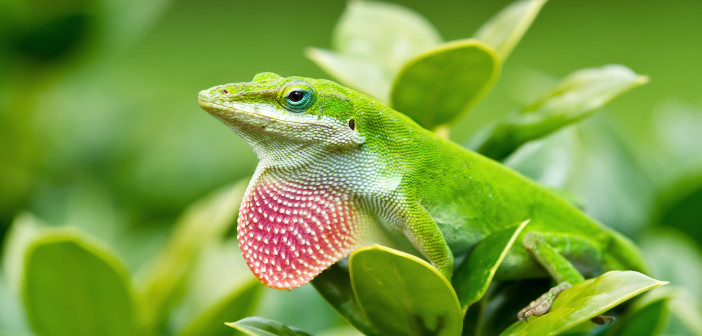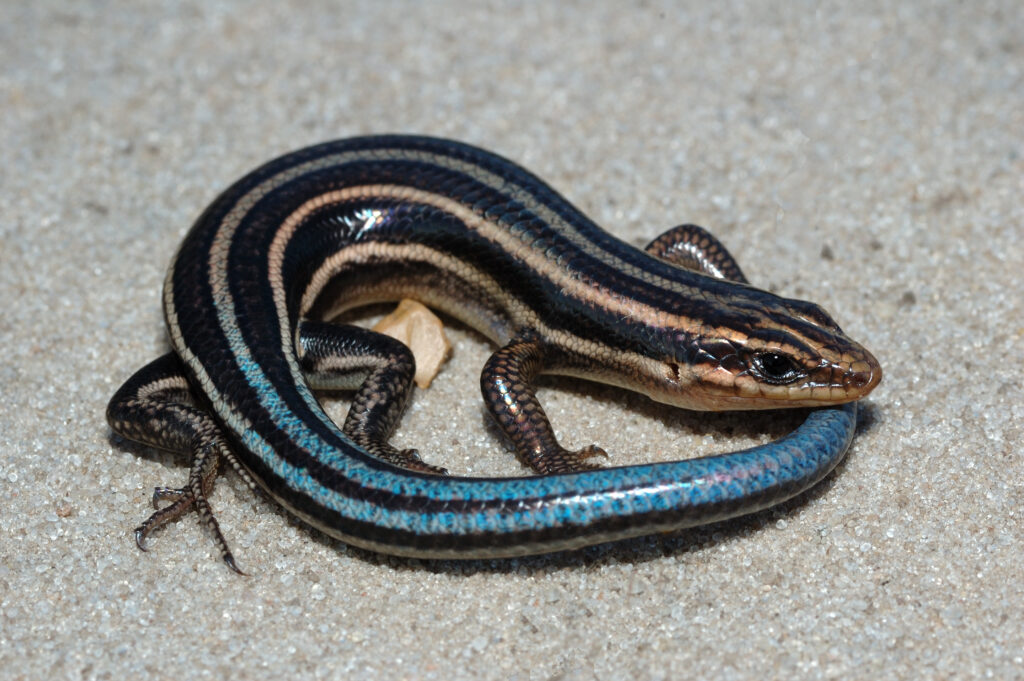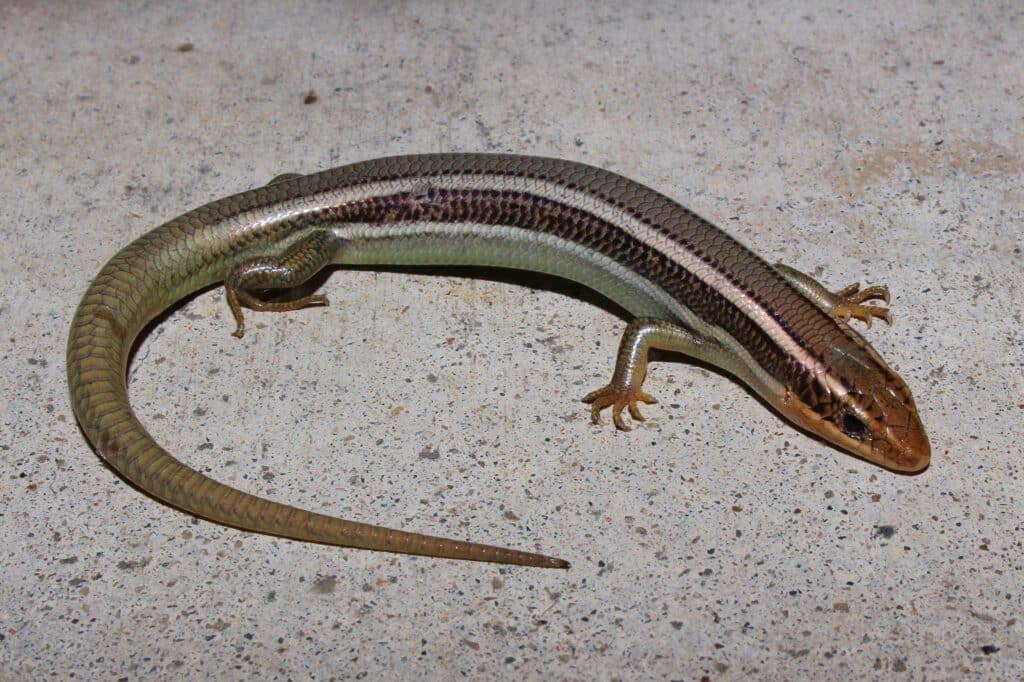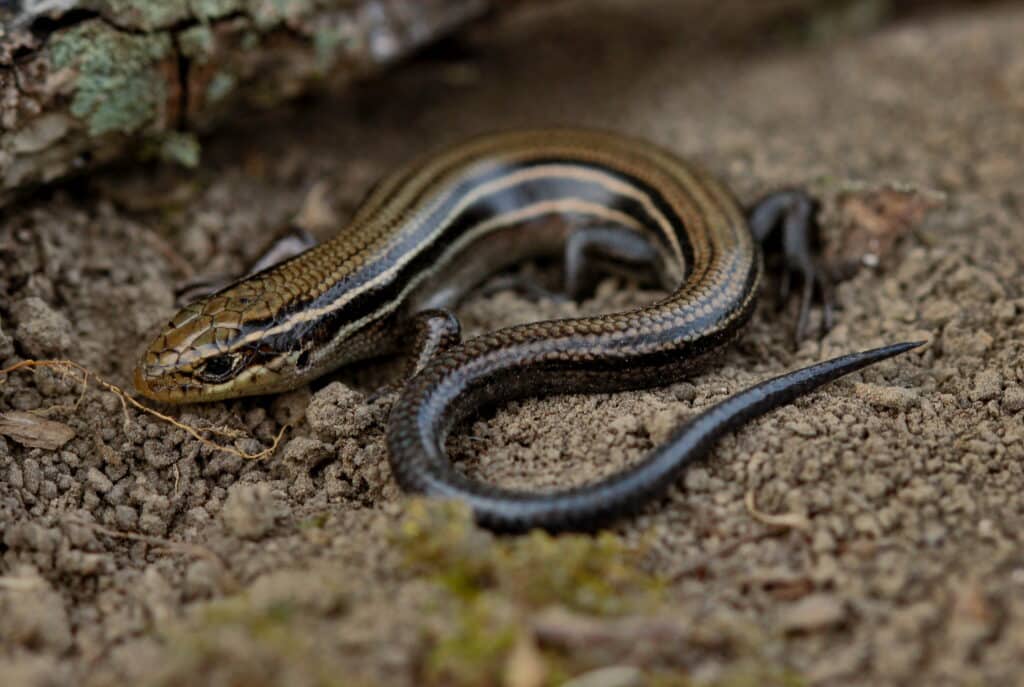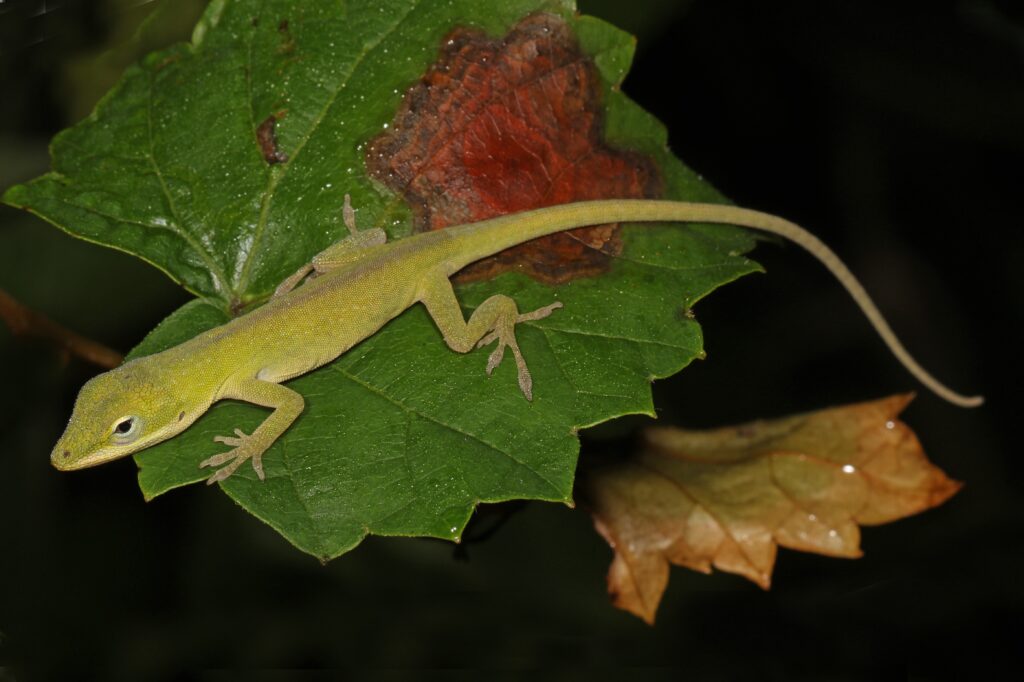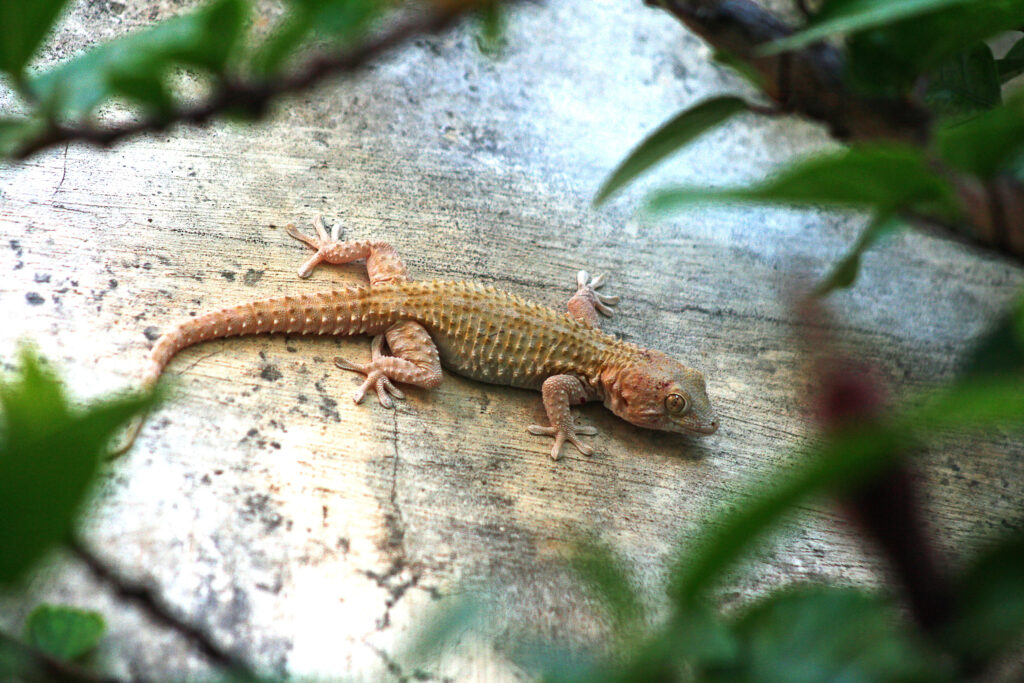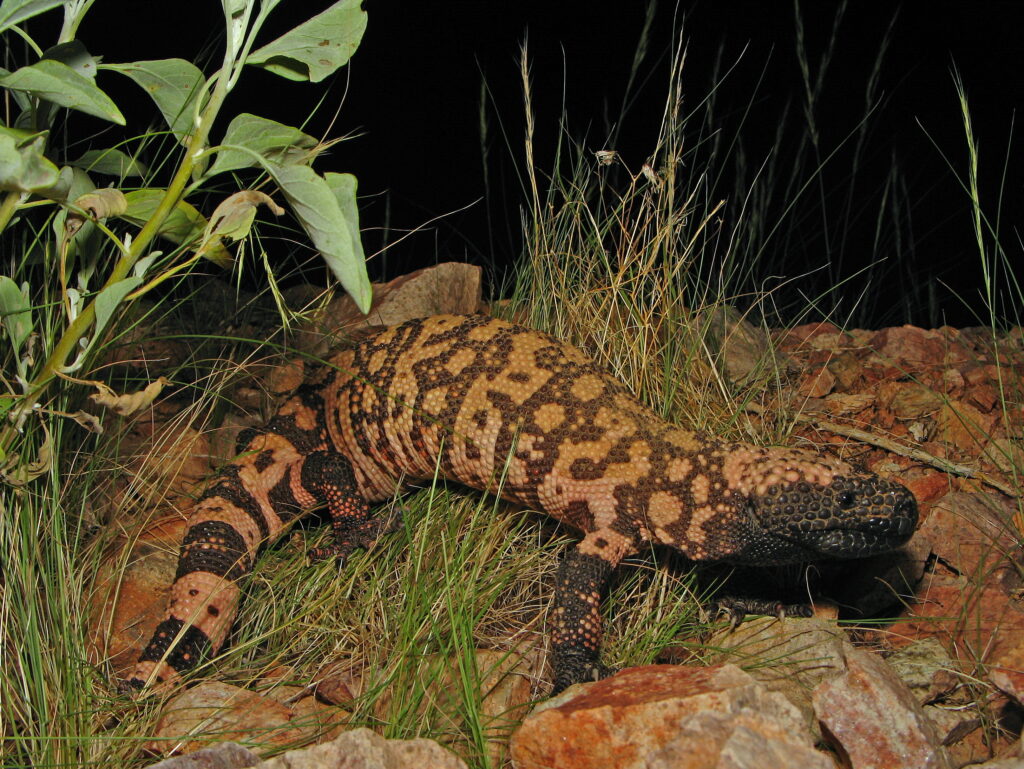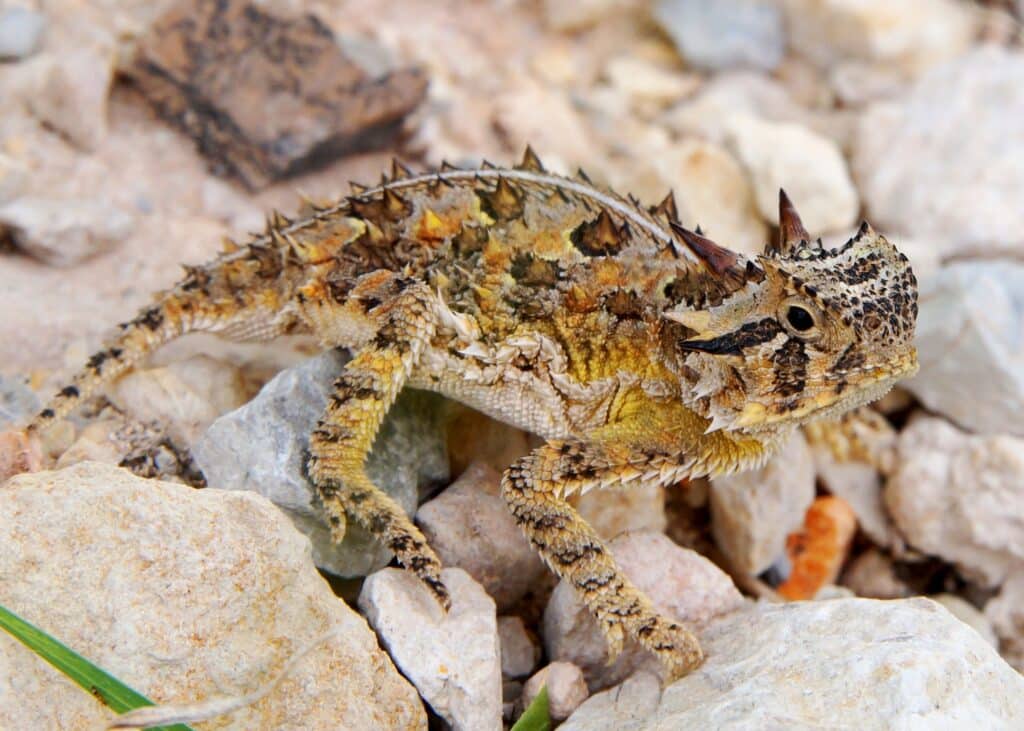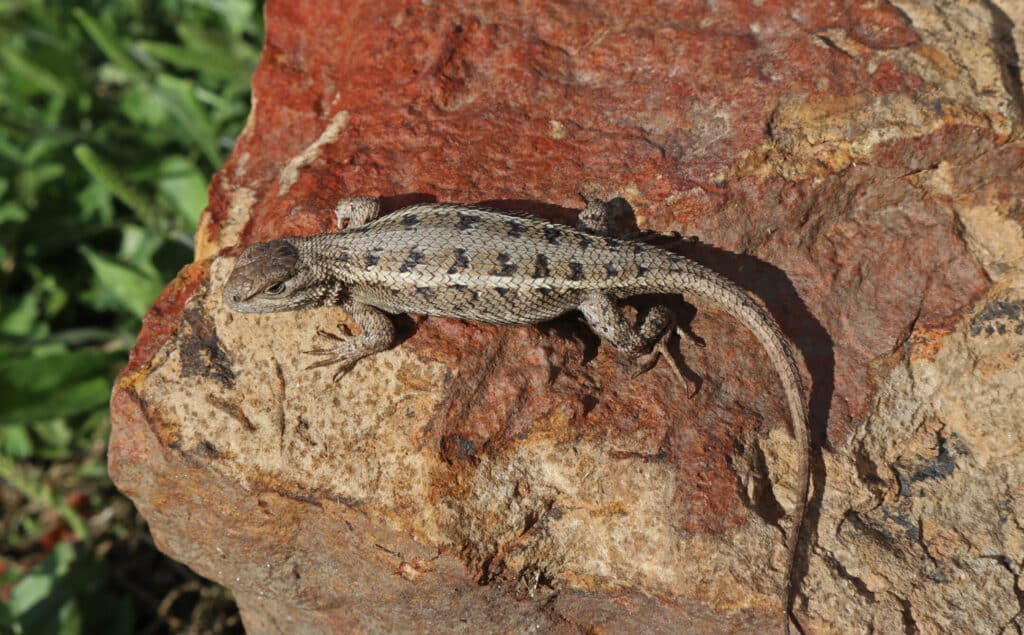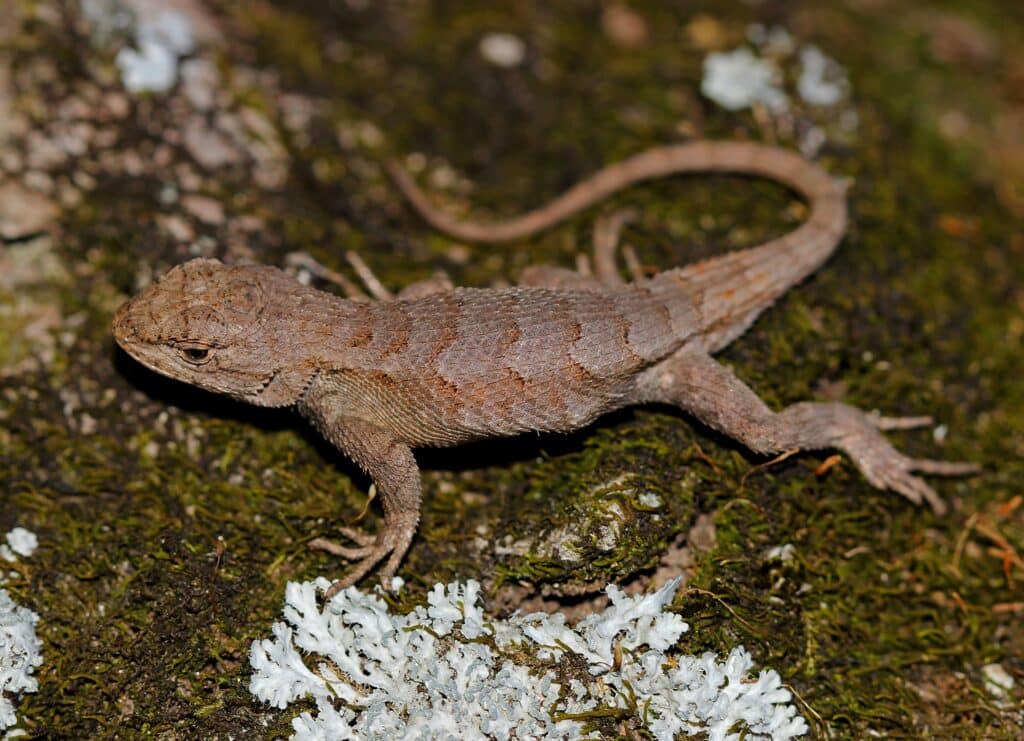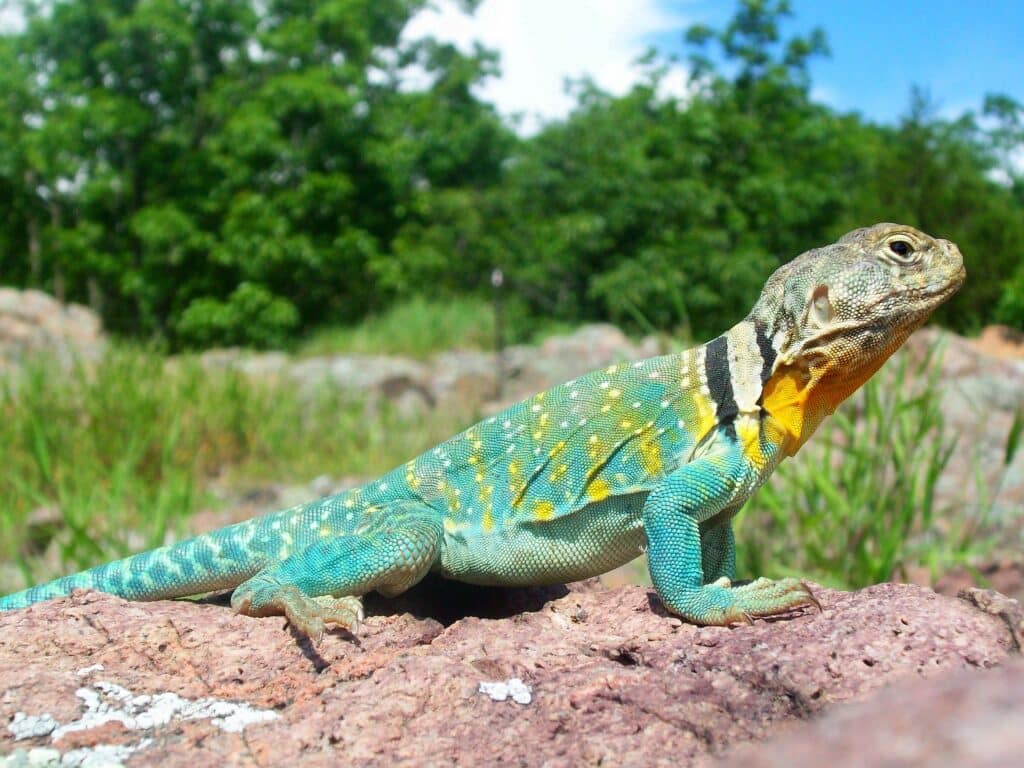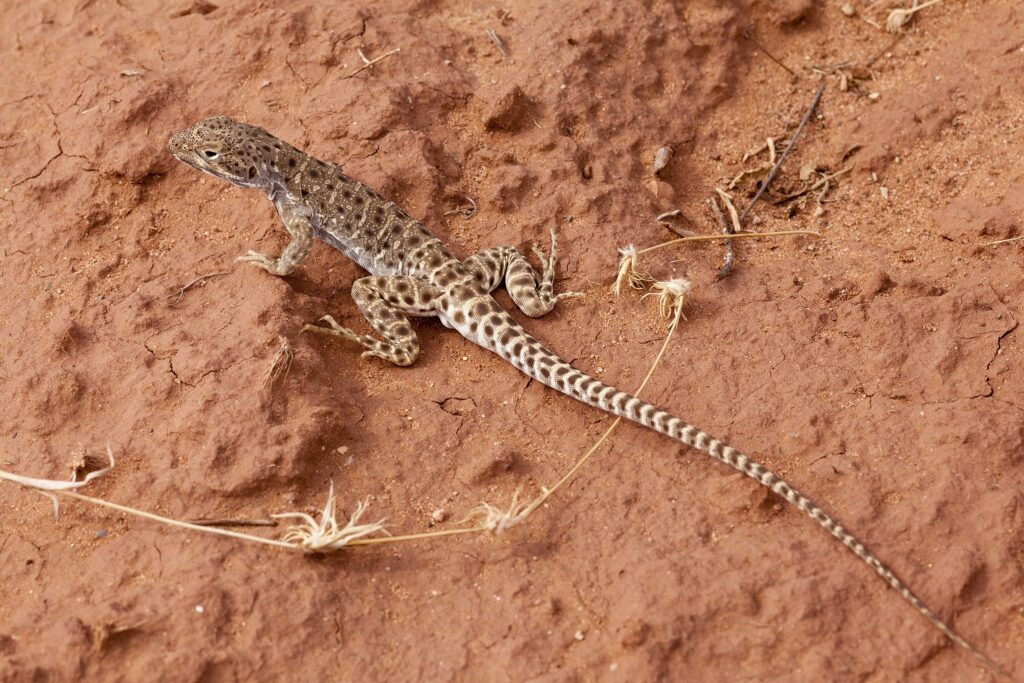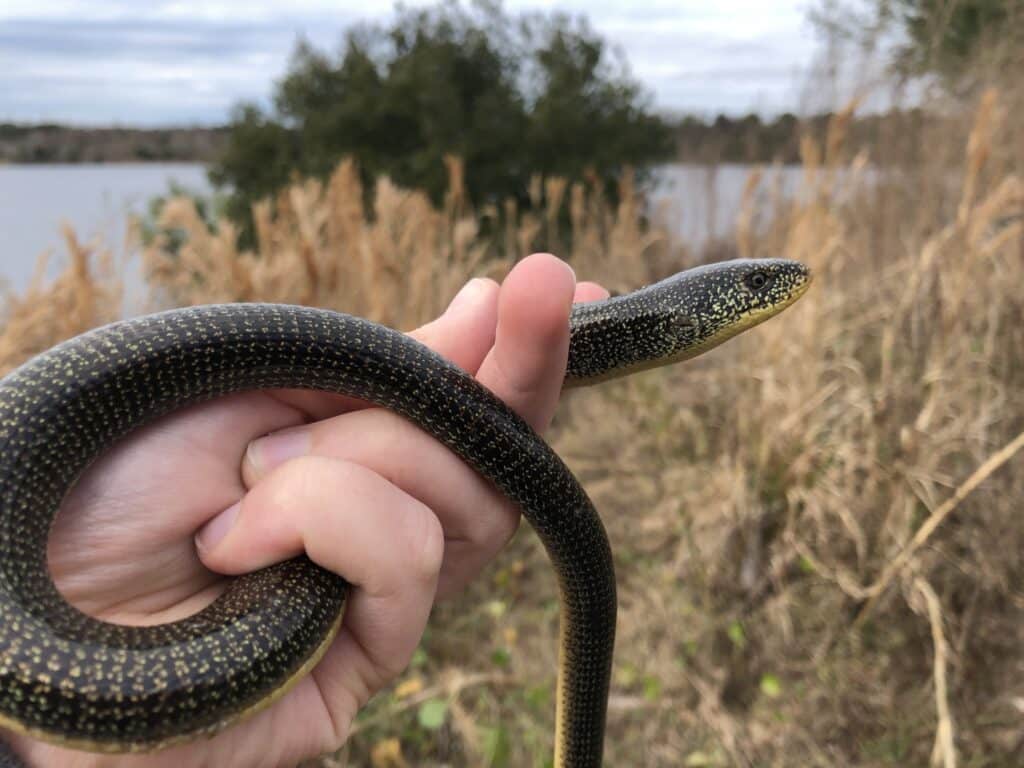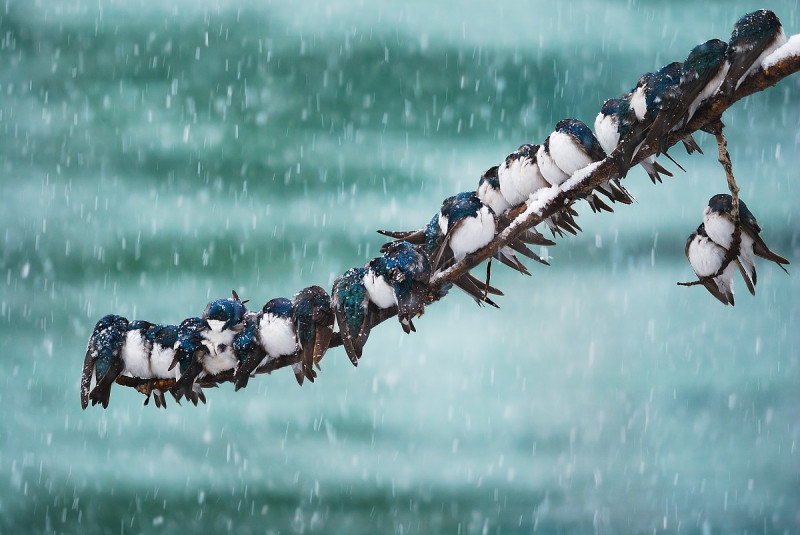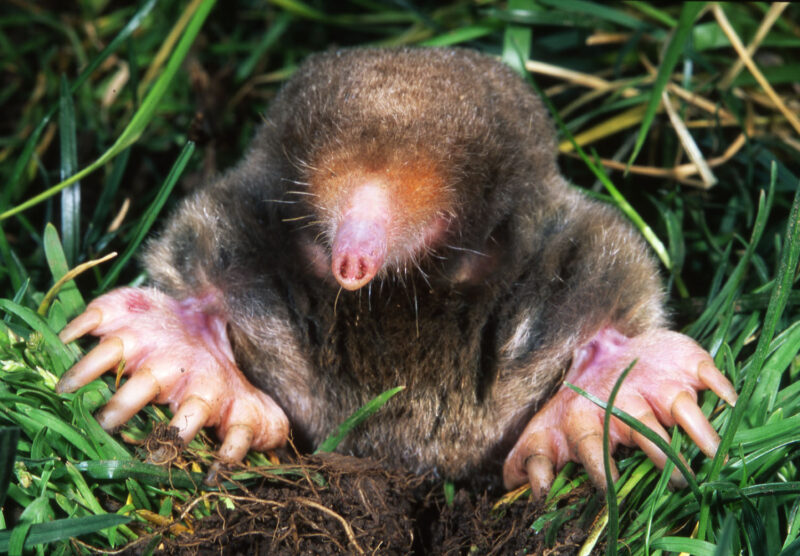No matter where you live, lizards are probably some of your backyard wildlife but stay out of sight. Or, maybe not—perhaps you’ve spotted them basking in the sun? The term “lizard,” by the way, doesn’t correspond to a distinct taxonomic category. Instead, it encompasses multiple families and genera, including anoles, geckos, skinks, chameleons, and iguanas, among others. While these different groups share certain morphological features, “lizard” is more a vernacular label than a scientific classification. Lizards are reptiles in the order Squamata and characterized by elongated bodies, and, unlike snakes, they have external ears and movable eyelids.
Notable physical characteristics
Anoles are known for their ability to change color and display a dewlap, a colorful throat fan used in communication, and territorial displays, like the one you see in the photo above. Geckos are distinguished by their large eyes with vertical pupils, specialized toe pads enabling them to climb vertical surfaces, and often nocturnal behavior. Skinks, recognized by their smooth, shiny scales and often cylindrical bodies, typically possess reduced or absent limbs, with some species displaying semi-aquatic tendencies. Iguanas are huge lizards with a dewlap, scaly skin, and spines. Chameleons can change their colors in a flash.
There are over 7,000 recognized species of lizards worldwide, with new ones still being discovered and described. Around 140 to 150 species are native to North America. All lizards play important roles in ecosystems as predators and prey, each displaying unique adaptations suited to their respective habitats and lifestyles.
Sizes range from gigantic to itty bitty
Lizards vary widely by size. For example, the Komodo dragon, Varanus komodoensis, which inhabits four Indonesian islands, holds the title of the largest lizard species in the world. These impressive reptiles can reach lengths of up to 10 feet (3 m) and weigh over 150 pounds (70 kg). In contrast, there’s the tiny Jaragua Sphaero, Sphaerodactylus ariasae, considered the smallest species in the world, with adults measuring only about 0.6 inches (16 mm) in length. The largest lizard in the United States is the Gila Monster, Heloderma suspectum, an intimidating 22 inches (56 cm) long. The smallest in the U.S. is the Reef Lizard, Sphaerodactylus notatus, only 2 inches (5 cm) long.
Behavior
The vast majority of lizard species are harmless to humans, although a few, such as the Gila Monster, possess venomous bites or may transmit diseases.
Lizard behavior varies widely among species, but they’re generally ectothermic (cold-blooded), relying on external sources of heat to regulate body temperature, and are most active during the day (diurnal). They engage in various behaviors, such as basking in the sun to warm up, hunting for prey, mating displays, and territorial defense. Lizards aren’t known for vocalizations, but some species, such as anoles and geckos, may produce various sounds, including chirps, clicks, and hisses, as part of communication and territorial behavior.
Lizards reproduce sexually, with males typically engaging in elaborate courtship displays to attract females. Most species lay eggs, though a few give birth to live young (viviparity). Lifespan varies widely, with smaller species generally living a few years in the wild, while larger ones may live for several decades in captivity.
A look at some that might visit your yard
Shown below are a few you might spot in your yard. They’re common species that represent various regions of the U.S. and inhabit urban areas where there’s a suitable environment.
Five-lined Skink, Plestiodon fasciatus
The Five-lined Skink is the most common lizard in the U.S. It’s about 4.9 to 8.5 inches (12.5–21.5 cm) long. Young ones are dark-brown to black with white to yellowish stripes and a bright blue tail. The colors fade with age, and the stripes may slowly disappear altogether. Older ones may be all-brown. They can shed their tail if a predator grabs it, then regenerate it. They prefer moist, hardwood areas with a permanent water source.
Western Skink, Plestiodon skiltonianus
Western Skinks are active in the daytime, aren’t aggressive or dangerous to humans, and won’t bite unless provoked. They measure about 4.0 to 8.25 inches (100–210 mm) in length. The juveniles have an incredible blue tail, which makes them cute, but please don’t take them from the wild. These lizards are predators of crickets, beetles, moths, grasshoppers, and other arthropods, so it’s good to have them patrolling your yard. In the U.S., they’re found from the Pacific Northwest to the southern tip of California and east to northern Arizona and Utah. Their preferred habit is dry woodlands, grasslands, along the banks of creeks, and in forest clearings.
Northern Prairie Skink, Plestiodon septentrionalis
The Northern Prairie Skink is 4 to 7 inches (10–18 cm) long. They’re found in prairie regions east of the Rocky Mountains. Look for them in open habitats, including grasslands, prairies, meadows, and woodland edges, especially where there’s loose soil for burrowing. Their diet comprises small insects, spiders, worms, and other invertebrates.
Green Anole, Anolis carolinensis
Anoles aren’t dangerous, don’t produce toxins, and are harmless to humans. They climb trees very well and super-fast, using sharp claws and finger and foot pads covered with microscopic hooks. Their color can change in shades of green to brown or mottled, kind of like a chameleon, but not quite as well. They eat a wide variety of insects, including grubs, cockroaches, and flies, so they’re great to have in your garden. Look for them on steps, trellises, and railings near foliage. If it gets too hot, they move to a shady spot to cool down. They’re found in the southeastern U.S. in swamps, forests, wooded beaches, yards, and other areas with trees.
Mediterranean House Gecko, Hemidactylus turcicus
The Mediterranean House Gecko inhabits much of the world. Introduced into the U.S., they live in the southern parts of the country, often near human dwellings. Tiny nocturnal lizards no more than 4–5 inches (10–13 cm) long, they’re very beneficial as predators of insects, especially moths and roaches. You may have seen them sitting motionless under lights at night. In the daytime, they shelter under rocks and wood, in crevices and holes, and under loose siding or shingles.
Wondrous gecko feet
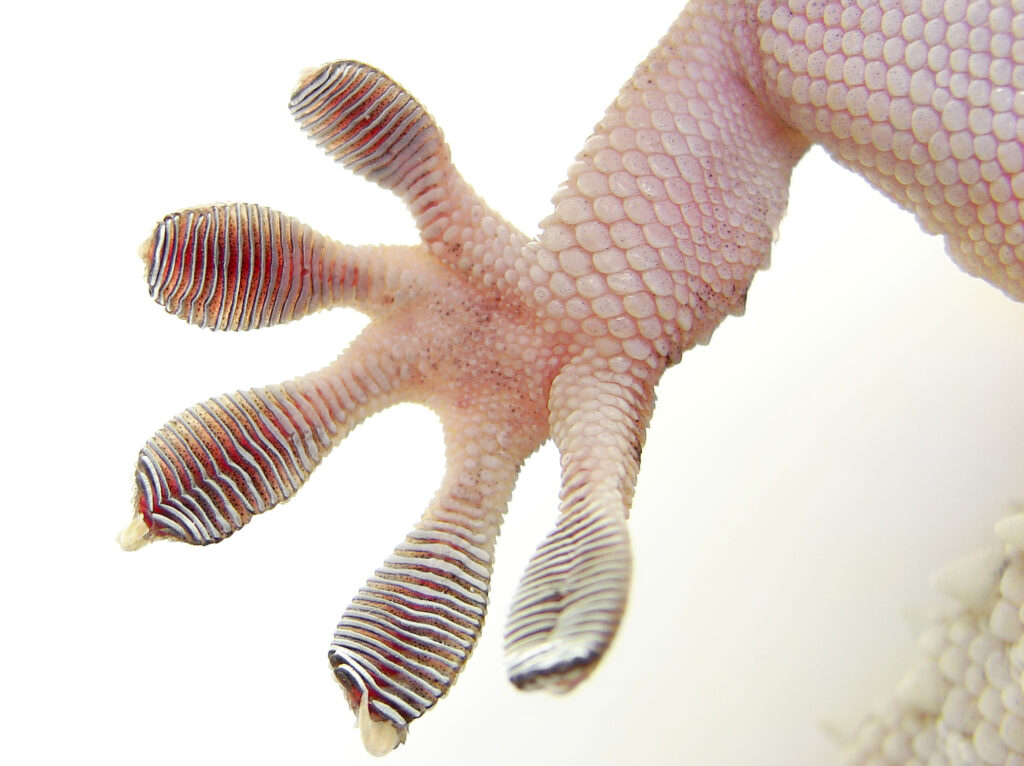
Underside of the foot of a Ringed Wall Gecko, Tarentola annularis (Matt Reinbold / Flickr; CC BY 2.0)
Geckos can easily run up and down surfaces, even polished glass. How? Because of millions of microscopic hairs on the bottom of their feet that work like an adhesive and can grasp even the slightest imperfection. Each hair is 100 millionths of a yard (0.9 m) long and has 1,000 spatula-shaped tips only 200 billionths of a yard wide—less than the wavelength of visible light! A million hairs will fit on a dime but can lift forty-five pounds.
Gila Monster, Heloderma suspectum
There are two subspecies of the Gila Monster in the U.S.—the Reticulated and the Banded. They live in desert and semi-arid regions of the Southwest. If you have them visiting your yard, be careful. They grow so large—up to about 22 inches (56 cm) in total length—it’s unlikely you’ll overlook an adult, and you definitely don’t want to get close. They’re slow-moving and tend to avoid humans, but they’re venomous, and if one gets you, it’ll deliver agonizing pain. And, often, they won’t let go. They’re similar in appearance, except one has a reticulated pattern, and the other has an unbroken band across its back. They feed on small mammals, lizards, frogs, and insects and often raid nests. They will also eat carrion.
Texas Horned Lizard, Phrynosoma cornutum
The Texas Horned Lizard is in the family Phrynosomatidae. It’s renowned for its distinctive appearance, featuring a flattened body, pointed snout, and prominent horn-like projections on its head. Adults typically measure between 3–5 inches (7.6–12.7 cm) in length, with females generally larger than males. Their diet primarily consists of ants, with harvester ants being a particularly favored food source. They’re native to the southern U.S., particularly Texas, as well as parts of Oklahoma, New Mexico, and northern Mexico. They inhabit various arid and semi-arid habitats, including grasslands, scrublands, deserts, and open woodlands, where they rely on sandy or loose soils for burrowing and thermoregulation.
Eastern Fence Lizard, Sceloporus undulatus
The Eastern Fence Lizard is common in the eastern U.S. Adults typically measure 4 to 7 inches (10–18 cm) in length, with males often larger and more brightly colored than females. They inhabit a variety of open habitats, including forests, woodlands, fields, and rocky outcrops, where they are often found basking on tree trunks, fences, or rocks. They’re opportunistic omnivores, feeding on a diverse diet that includes insects, spiders, small invertebrates, and occasionally plant matter.
Southern Prairie Lizard, Sceloporus consobrinus
The Southern Prairie Lizard inhabits the Midwest and southern states from Nebraska south to Texas and west to Arizona, New Mexico, and Colorado. It’s characterized by a relatively small size, with adults typically measuring 3 to 5 inches (7.6–12.7 cm) in length. They inhabit grasslands, prairies, savannas, and scrublands, where they can be found basking on rocks, logs, or low vegetation, and are often seen darting between patches of cover. They feed primarily on a diet of small insects and other invertebrates, such as beetles, ants, grasshoppers, and spiders.
Common Collared Lizard, Crotaphytus collaris
The Common Collared Lizard is a striking reptile notable for its vibrant coloration; males display brilliant blue or turquoise markings on their bodies and throats during the breeding season. Adults typically measure 8 to 14 inches (20–35 cm) in length, with males often larger and more brightly colored than females. They’re widely distributed across Texas, Oklahoma, Kansas, New Mexico, and Arizona. They inhabit a variety of arid and semi-arid habitats, including desert scrublands, rocky slopes, canyons, and open grasslands, where they can be found basking on rocks, boulders, or tree branches. They feed primarily on a diet of insects, spiders, small reptiles, and occasionally small mammals and birds.
Long-nosed Leopard Lizard, Gambelia wislizenii
Named for their elongated snout and distinctive spotted pattern resembling a leopard, adults are 6 to 9 inches (15–23 cm) long, with males often larger than females. They’re widely distributed across their range, which includes parts of California, Nevada, Arizona, Utah, New Mexico, Texas, and northern Mexico. Arid and semi-arid habitats, including desert scrublands, grasslands, sandy washes, and rocky slopes, are their homes. They can be found basking in the sun or seeking refuge under rocks and crevices. Insects, such as grasshoppers, beetles, and ants, are their primary diet, but they’ll also feed on small reptiles, including lizards and small snakes.
Eastern Glass Lizard, Ophisaurus ventralis
The Eastern Glass Lizard is a legless lizard native to the southeastern U.S. Despite its resemblance to snakes, it has distinct eyelids and external ear openings, which snakes don’t have. Adults can reach lengths of up to 24 to 42 inches (61–107 cm), with females typically larger than males. They’re found in various habitats, including grasslands, forests, and open woodlands, preferring areas with loose soil or sandy substrates for burrowing. They’re primarily insectivores, feeding on a diet of insects, spiders, and other small invertebrates. Despite their snake-like appearance, they’re harmless to humans. Glass lizards are so-named because their tails are easily broken off.
Green Iguana, Iguana iguana
A large, arboreal lizard species native to Central and South America, the Green Iguana has found its way to Florida, Texas, and Hawaii due to the pet trade. Also known as the American Iguana or the Common Green Iguana, they can reach a length of up to 6.6 feet (2 m) from head to tail, but adults are typically 5.6 feet (1.7 m) and weigh 8.8 to 13.2 pounds (4–6 kg).
Green iguanas exhibit vibrant green coloration when young, which can fade to a more muted green, blue, or even orange as they age. Their rough skin has a row of spines along their back and tail, and they have a distinctive dewlap (a flap of skin under their chin), which they use for thermoregulation and communication. They thrive in warm, humid environments and primarily consume leaves, flowers, fruit, and other plant matter. Their feces contribute to seed dispersal.
Veiled Chameleon, Chamaeleo calyptratus
The most widespread and commonly encountered chameleon species in the U.S., the Veiled Chameleon is native to the Arabian Peninsula but has become established in Florida and Hawaii due to the pet trade. It’s known for its vibrant green coloration with yellow, blue, or white bands and a distinctive casque (helmet-like structure) on the head. They can reach lengths of up to 24 inches (60 cm). Their diet consists mainly of insects such as crickets and grasshoppers, but they also consume plant matter, including leaves and flowers, particularly when water is scarce. They’re not dangerous to humans but can deliver a painful bite if provoked.
These hummingbirds migrate thousands of miles
Think moths are drab? Check these out
In your yard: bats

